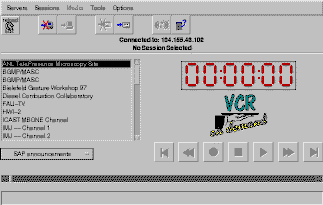MBone VCR on Demand Service
Sorry, this project is discontinued and not supported anymore!
Overview
MBone, the Multicast Backbone is one
of the most facinating technologies in the Internet today. It provides the infrastructure
for world-wide IP-multicasting,
and efficient point to multipoint, or even multipoint to multipoint communication
based on the Internet Protocol IP.
The MBone supports a variaty of applications where one of the most
popular application is world-wide audio/video-conferencing.
One of the standards to transmit audio/video data over the Internet is
RTP, the
Real-Time Transport Protocol (
Internet RFC 1889).
A number of public domain audio/video conference tools supporting IP-multicast
and RTP where developed and are available. A good overview can be found on the
MBone Home-Page at www.mbone.com.
More and more commercial vendors also support RTP and IP-multicast and offer
commercial application for audio-video conferencing.
The MBone VCR on Demand Project (MVoD) offers a solution for interactive remote
recording an playback of multicast videoconferences. This means the MVoD project offers
an environment where a user can interactively record audio/video conferences on a remote
server controlling it with a local client application and later the same user or even other
users can play the session back on demand per multicast or unicast.
MBone VCR on Demand stands for:
|
MBone Video Conference Recording on Demand
|
Architecture
The MBone VCR on Demand architecture consists of three components:
-
the MVoD Server, that deals with the user management
and the session management,
-
the MVoD Client, that offers the users a graphical
user-interface to access the MVoD Service and
-
the RTP DataPump, that is responsible for the recording
and playback, the synchronization and the administartion of the
RTP data streams.
For the communication between the above components, a number of protocols
have been developed:
-
the VCR Announcement Protocol (VCRAP) with which the server
announces its service to the clients,
-
the VCR Service Access Protocol (VCRSAP) through which
the clients have access to the server,
-
the VCR Stream Control Protocol (VCRSCP) that the clients
use to access and controll a session on the server and
-
the RTP DataPump Control Protocol (RDCP) that the server
uses to control the RTP DataPumps (one per session)
Moreover, we have implemented an interface to the Session Announcement Protocol
(SAP) through which the MVoD Server learns about ongoing MBone sessions.
A widely use tool that implements SAP to announce MBone sessions is SDR (Session Directory).
For the real-time data transfer the RTP DataPump fully implements RTPv2.

Implementation
Both, MVoD Client as well as MVoD Server are implemented using the platform
independent programming language Java.
This means that we can support access to the MVoD Service from any platform
that supports Java. The communication between client and server is implemented
using
Java IDL, developed by
SUN Microsystems, a Corba (Common
Object Request Broker Architecture) complient environment fully implemented
in Java.
For performance reasons, the RTP DataPump is implemented in C++, the communication
between RTP DataPump and MVoD Server is implemented with RDCP, a fully textbased Protocol
much like RTSP. In fact, RDCP can be seen as a subset of the functionality of RTSP, limited to RTP data streams and the functionality provided by the RTP DataPump. We plan to implement RTSP as Control Protocol to access the RTP DataPump in one of the next versions.
Here you see a screenshot of the graphical user interface of the MVoD Client, implemented
with the Java AWT:

MVoD Service Software
Check here what the latest version is.
Related publications and documentation
Wieland Holfelder:
Interactive Remote Recording and Playback of Multicast Videoconferences
Paper appeared
at the 4th. International Workshop on Interactive Distributed Multimedia Systems
and Telecomminication Services (IDMS '97), Technical University of Darmstadt, Germany
Contact
|
Last Changed: October 14. 1997
|







